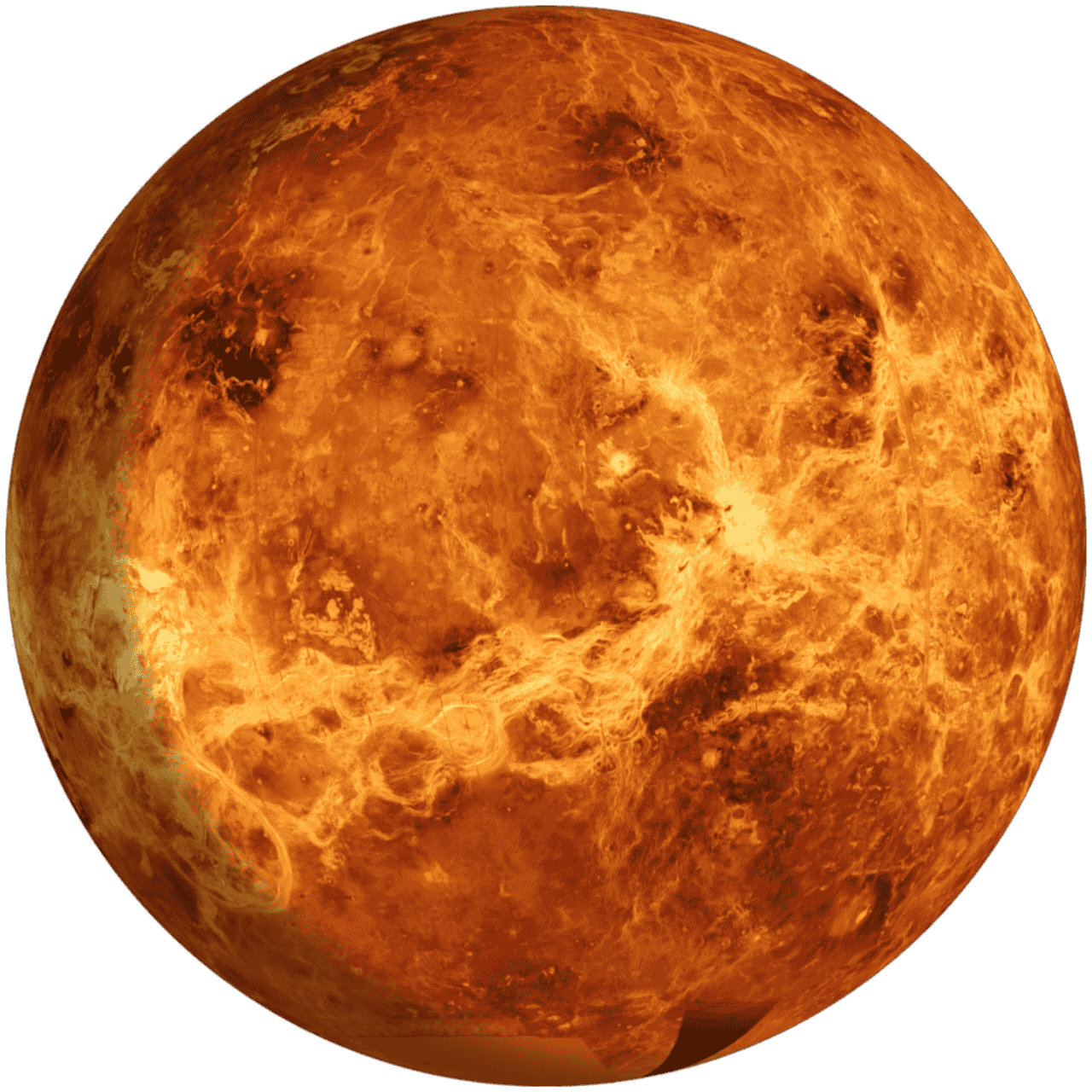Venus
Goddess of Love
The hottest planet in our solar system with a thick, toxic atmosphere

Composition
Iron core, rocky mantle, and basaltic crust
Atmosphere
96% carbon dioxide with sulfuric acid clouds
Cosmic Portrait
Venus: The Hottest Planet in the Solar System
Venus—or as I like to call it, Earth’s fiery twin. Despite being just our neighbor, Venus hides one of the most extreme climates known to humanity. It’s not just sweltering—it’s relentless, hazardous, and completely unrelenting. But man, the science tucked behind all that heat is absolutely fascinating.
Overview of Venus
Venus is the second planet from the Sun, virtually matching Earth in size and structure but spinning in retrograde. It’s labeled thehottest planetfor a reason: surface temperatures soar to an average of about 462 °C (864 °F), hot enough to melt lead. Remarkably, that superheated environment stays consistent—day, night, equator, or pole.
Structure & Internal Composition
Beneath those oppressive clouds, Venus has a familiar build: a silicate crust, a rocky mantle, and a core estimated around 3,000 km in radius—similar to Earth's. What’s different? Its magnetic field is nearly nonexistent, hinting the core could be mostly solid or that internal convection is inefficient at generating a dynamo like Earth’s.
Atmosphere, Climate & Weather Patterns
Venus holds an atmosphere packed full of carbon dioxide—over 96%—with nitrogen at 3.5%, and trace sulfur dioxide. At its surface, the pressure towers at nearly 92–93 bar—that’s equivalent to being 900 meters underwater on Earth.
Thick clouds of sulfuric acid blanket the planet, reflecting much of the sunlight, yet trapping heat in a runaway greenhouse effect. That effect keeps surface temps at a steady ~467 °C regardless of time or location.
Wind patterns are just as wild: at cloud-top levels, winds whip at up to 360 km/h, circumnavigating the planet in just four Earth days—far faster than Venus itself rotates (which takes 243 days). Meanwhile, lightning flickers in the clouds, and sulfuric acid rains evaporate before they reach the surface.
Surface & Geological Activity
Venus’ crust is primarily basaltic, about 10–20 km thick, littered with vast volcanic plains, rifts, and thousands of volcanoes—some possibly still active. Its crater count is surprisingly low, suggesting a surface resurfaced as recently as 300–600 million years ago.
Infrared observations and volcanic gas detections hint at lingering volcanic activity, reshaping the planet’s face over time.
Exploration & Upcoming Missions
Humanity’s curiosity has carried many missions to Venus. From Mariner 2 and Pioneer Venus, to Magellan’s radar mapping, Europe’s Venus Express, and Japan’s Akatsuki—each added layers of insight.
Up next: *VERITAS* (NASA) aims to deliver high-resolution surface maps and geological history; *EnVision* (ESA) will study volcanoes and climate interplay; *India’s Venus Orbiter Mission* brings a multi-instrument payload for atmospheric and surface dynamics. All aim for the early 2030s.
Table: Venus — Quick Facts
| Feature | Detail |
|---|---|
| Distance from Sun | ~108 million km |
| Diameter | ~12,104 km |
| Rotation | 243 Earth days (retrograde) |
| Solar Day | 117 Earth days |
| Surface Temp | ~462 °C |
| Atmospheric Pressure | ~92–93 bar |
| Atmosphere | CO₂ ~96.5%, N₂ ~3.5% |
| Volcanoes | Thousands; some possibly active |
GEO & AEO: Popular Questions About Venus
- Why is Venus hotter than Mercury?
- Because Venus’ dense CO₂ atmosphere traps heat far more effectively than Mercury’s near-absent atmosphere—Venus stays toasty even though it’s farther from the Sun.
- Could there be life on Venus?
- Surface? No way. But some scientists speculate that the cloud layers (~50–60 km up) might offer hospitable temperatures and pressures. And yes, research shows some organic molecules remain stable in sulfuric acid droplets there—making cloud-life speculation plausible.}
- Does Venus have seasons?
- It doesn’t. Its tilt is just ~3°, and with its slow, retrograde spin, there's virtually no seasonal variation. Heat stays consistent across both poles and equator.
- Is there lightning on Venus?
- Yes—scientists have observed intermittent lightning in its dense clouds, likely tied to volcanic activity or atmospheric dynamics.
- What did early solar system models say about Venus?
- Recent studies suggest Venus, Earth, and early Mars may have formed in a rhythmic orbital resonance in the first 10 million years before giant planet movements broke the pattern. Venus didn’t endure massive impacts like Earth, making it a possible record-keeper of early solar system history.
Why Venus Still Captivates
Venus may look like a dull, featureless orb behind blinding clouds—but that’s the lure. It’s an extreme environment and a cautionary tale, offering a look at runaway greenhouse processes in full throttle. Floating missions, clouds that might support life, volcanoes still flowing—Venus is a planet full of unanswered questions and jaw-dropping science.
Fun Fact
Venus rotates backwards compared to most planets, and a day on Venus is longer than its year!